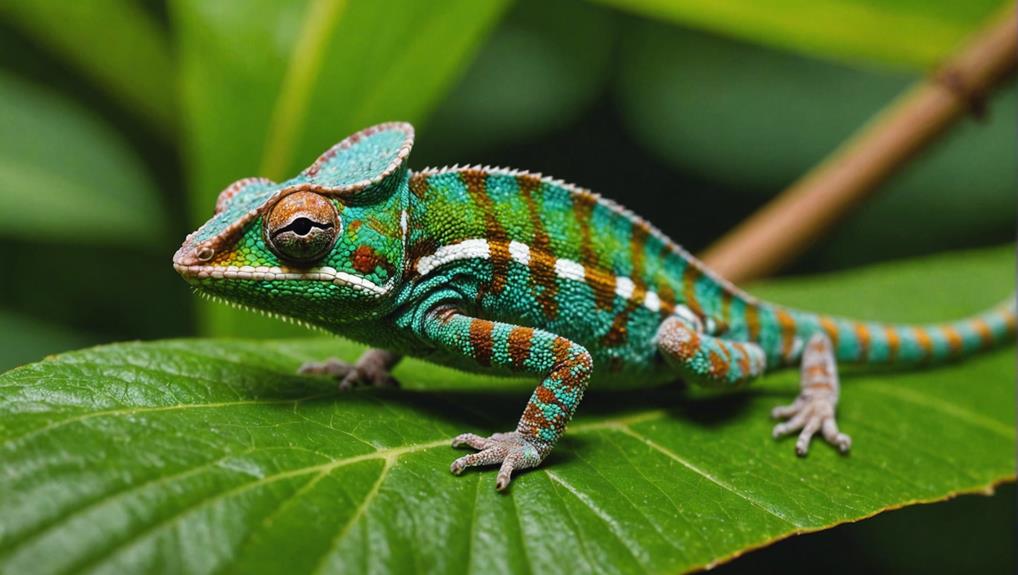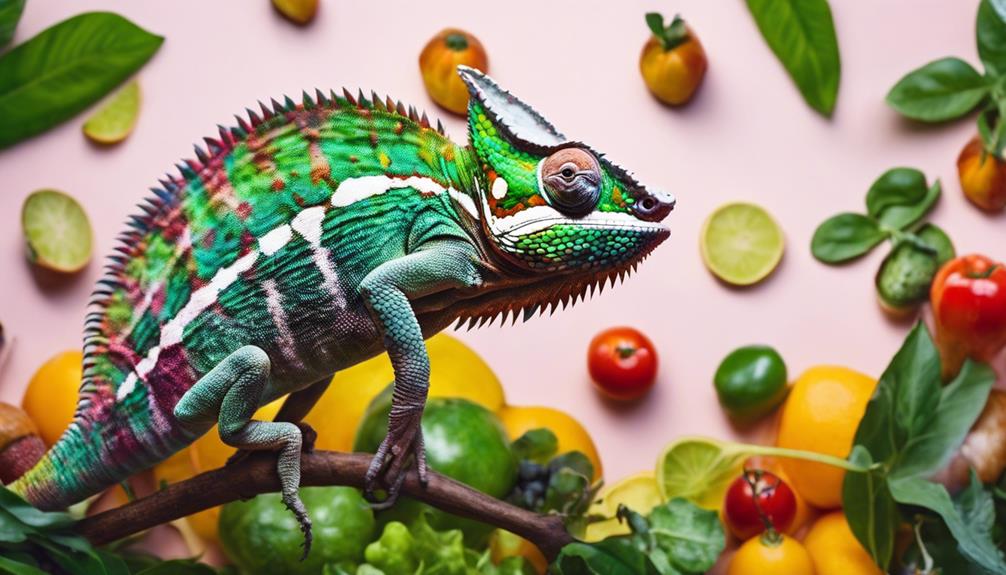Meet the Pygmy Chameleon: A Tiny but Mighty Reptile
Pygmy chameleons, measuring just 1.5-2 inches in length, are among the smallest of their kind. They inhabit the humid forests of Central and East Africa, where their exceptional camouflage skills allow them to blend seamlessly into the leaf litter. Their prehensile tails and independent eye movement aid in navigating dense vegetation.
These tiny reptiles feed primarily on small insects, which they catch with their long, sticky tongues. Solitary animals, they only come together to mate, and their lifespan is a short 1 to 3 years.
However, their populations are threatened by habitat loss and the pet trade. As a result, conservation efforts are necessary to protect these unique creatures.
There's still much to learn about the fascinating world of pygmy chameleons.
Unique Camouflage Techniques
Blending seamlessly into their surroundings, pygmy chameleons use their exceptional camouflage skills to avoid predators and surprise prey. You'd be amazed at how these tiny creatures can adapt their color to match the environment around them. This fascinating ability, known as color adaptation, allows them to blend in with leaves, branches, and other natural elements.
By doing so, they can effectively hide from potential threats while also sneaking up on insects for a quick meal.
Pygmy chameleons take environmental mimicry to the next level. Unlike other animals that might only change shades, these chameleons can alter their entire appearance to mirror their surroundings. They don't just change color; they can also adjust the texture and pattern of their skin, making them nearly invisible to the untrained eye.
This means that whether they're in a dense forest or a more open area, they've the tools to stay hidden and safe.
You might wonder how they manage these impressive feats. Pygmy chameleons have specialized cells in their skin called chromatophores. These cells contain different pigments that can expand or contract to produce various colors.
When a chameleon wants to blend into its environment, it signals these cells to adjust, creating the perfect camouflage.
Habitat and Distribution
Nestled in the verdant forests of Central and East Africa, pygmy chameleons thrive in humid, densely vegetated environments. You'll often find these tiny reptiles making their homes on the forest floor, where they blend seamlessly with the leaf litter and undergrowth. This habitat provides them with ample opportunities to hide from natural predators like birds, snakes, and larger reptiles.
These chameleons are masters of their domain, using their unique camouflage to stay hidden from threats. The forest floor offers the perfect cover with its mix of fallen leaves, twigs, and dense vegetation.
They prefer areas with abundant moisture, as their small size makes them particularly susceptible to dehydration. The humidity around the forest floor helps them maintain the necessary moisture balance they need to survive.
Pygmy chameleons aren't widespread but are concentrated in specific regions within Central and East Africa. Countries like Tanzania, Kenya, and Uganda are known to harbor these miniature marvels.
They favor primary and secondary forests, where the canopy provides a consistent microhabitat ideal for their survival.
When you explore these regions, you'll notice that the pygmy chameleon's choice of habitat is strategic. Living close to the forest floor allows them to access a variety of hiding spots and maintain a low profile.
It's a life of constant vigilance, always on the lookout for natural predators while taking advantage of the rich resources their environment provides.
Diet and Hunting Behavior
Pygmy chameleons primarily feast on small insects like ants, termites, and tiny flies, showcasing their impressive hunting skills. They rely on their excellent camouflage to blend into their surroundings, making them nearly invisible to both prey and predators. When they spot an unsuspecting insect, they move with deliberate slowness to avoid detection.
Their feeding habits are quite intriguing. Pygmy chameleons have a specialized diet that revolves around small insects. They use their sticky, extendable tongues to snatch prey with remarkable precision. This quick and efficient feeding method allows them to capture insects that might otherwise be too fast to catch.
Pygmy chameleons don't need a large territory to find their food. They can thrive in a relatively small area, as long as it provides enough insects. This adaptability makes them well-suited to their natural habitats, which often include dense foliage and leaf litter. They're opportunistic feeders, meaning they'll eat whatever small insects are available, adapting their diet based on their immediate environment.
Pygmy chameleons' hunting behavior also involves a lot of patience. They can stay still for long periods, waiting for the perfect moment to strike. This patient hunting strategy is vital for their survival, as it conserves energy and increases their chances of a successful catch.
Reproduction and Lifespan
When it comes to reproduction, pygmy chameleons have some unique and fascinating characteristics.
These tiny creatures engage in mating rituals that are as intriguing as they're specific. During the mating season, male pygmy chameleons display vibrant colors and perform a series of movements to attract females. If a female is receptive, she'll allow the male to mate with her, which can take anywhere from a few minutes to an hour.
After mating, the female pygmy chameleon goes through a process of egg incubation. She'll lay her eggs in moist soil or leaf litter, where they remain safely hidden from predators. The incubation period typically lasts between 45 to 90 days, depending on environmental conditions like temperature and humidity. You might be surprised to learn that the eggs remain unattended during this time. The young chameleons are independent from the moment they hatch, completely free to explore their surroundings.
Three key points about pygmy chameleon reproduction and lifespan:
- Mating Rituals: Males perform colorful displays and movements to attract females.
- Egg Incubation: Eggs are laid in moist soil or leaf litter and incubate for 45 to 90 days.
- Lifespan: Pygmy chameleons typically live for 1 to 3 years in the wild, although some can live longer in captivity under ideal conditions.
Understanding these aspects of pygmy chameleon reproduction gives you a glimpse into the delicate balance of nature and the incredible adaptability of these tiny reptiles. It's a demonstration of their survival instincts and the intricate processes that sustain their population in the wild.
Conservation Status
While understanding their reproduction and lifespan gives insight into their survival, it's equally important to examine the conservation status of pygmy chameleons. These tiny reptiles are facing significant challenges that threaten their existence. One of the primary concerns is population decline. Deforestation, habitat destruction, and the illegal pet trade have all contributed to the dwindling numbers of pygmy chameleons in the wild.
To better understand their plight, let's look at some key factors affecting their conservation status:
| Factor | Impact |
|---|---|
| Deforestation | Loss of habitat |
| Illegal Pet Trade | Overexploitation |
| Climate Change | Altered living conditions |
| Invasive Species | Increased competition and predation |
| Conservation Efforts | Protection measures and awareness |
Deforestation is perhaps the most immediate threat, as it leads to a direct loss of the pygmy chameleon's natural habitat. When forests are cleared for agriculture or urban development, these tiny creatures lose the environment they depend on for survival. The illegal pet trade also plays a significant role in their population decline. Despite laws and regulations, many pygmy chameleons are still captured and sold, reducing their numbers in the wild.
Climate change is another factor altering their living conditions. Shifts in temperature and weather patterns can disrupt their delicate ecosystem, making it harder for them to thrive. Invasive species, which may compete for resources or prey on pygmy chameleons, further exacerbate the situation.
However, there are protection measures in place. Conservation efforts focus on protecting their habitat, enforcing laws against illegal trade, and raising awareness about the importance of these unique reptiles. By supporting these initiatives, you can help safeguard that pygmy chameleons continue to enchant the natural world.
Conclusion
Pygmy chameleons are fascinating creatures with impressive camouflage techniques, adapted to various habitats.
They've a diverse diet and unique hunting behaviors, making them intriguing to study.
Their reproduction and lifespan add another layer of interest, while their conservation status reminds us of the importance of protecting these tiny reptiles.
By understanding their characteristics and challenges, you can appreciate the complexities of these remarkable lizards and the need to support their conservation.


